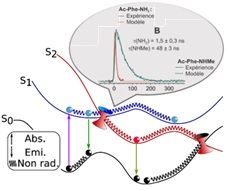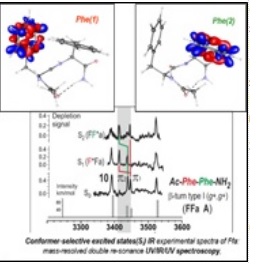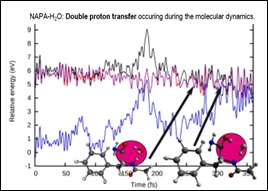Contact : V. Brenner, M. Mons
While the absorption of light by molecular systems and in particular biomolecules is ubiquitous in Nature and used in many fields of research, the understanding of the underlying ultrafast process following the photon absorption is still limited. Conformer-selective excited state dynamics of bio-relevant systems (isolated and hydrated peptides, or model complexes for chiral recognition) have been then investigated, in the frame of the ANR-funded ESBODYR project, through a synergetic experimental/theoretical approach :
(i) An original multi-step and multi-level theoretical strategy to efficiently and accurately model the excited states potential energy surfaces of these systems have been developed.
(ii) In parallel, novel experimental procedures coupling the measure of excited state dynamics by nano-, pico and femtochemistry techniques with the conformer-selectivity brought by IR spectroscopy or its variant in helium droplets have been implemented.

By unraveling the mechanisms at play after the absorption of a photon, the project aims at documenting how the electronic energy is eventually used (isomerization, chemical reaction) or released (light emission, thermal conversion) by the system; these processes being also of paramount importance in many field of applied research. In addition, the project promotes advances in technical developments, namely in modeling the fate of the energy absorbed, which has potential applications in fields as diverse as photochemistry, biology or material sciences.
¿ Nonadiabatic dynamics simulations (Excited state and conical intersection) : As the low-lying excited states of different nature of these systems need to be described simultaneously in a balanced and accurate way, an innovative theoretical approach has been developed. First, non-adiabatic dynamic simulations based on time-dependent density functional theory (TDDFT) have been performed to provide hints about the critical motions driving the deactivation. Second, the pathways have been then investigated at a better level of theory with the standard coupled cluster method to second order (CC2). Finally, in order to validate the standard method, an original multireference wavefunctions method in localized orbitals has been extended and applied to these systems.
° Conformer-selective laser spectroscopies (IR-UV/UV, IR in helium droplet) : From the experimental side, the IR/UV double resonance and time-resolved UV/UV spectroscopies are used to obtain crossed-checked information about structure and dynamics. Beyond the nano- and picosecond regimes, exploratory studies at the femtosecond regime were conducted to treat ultra-short-lived excited states. Besides, for systems devoid of a near-UV chromophore, IR spectroscopy in helium droplets has been developed and applied to a series of flexible molecules in order to detect the whole conformational population.
 |
Developed on small peptides (DOI: 10.1021/ja3054942 and 10.1039/C3CP53953A), the innovative computational strategy combining non-adiabatic dynamics simulations and mono-/multireference methods is now applied to model efficiently low-lying excited state potential energy surfaces in larger peptides, in peptide hydrates and in model complexes for chiral recognition. In addition, both a benchmark of the CC2 method on a set of model peptide chains (structure, energetic (DOI: 10.1039/C4CP03401E and 10.1021/jp509494c and vibrational frequencies of the first π π* excited state) as well as the assessment of the CC2 method validity from a comparison with MR methods have been be performed. Moreover, benchmark of new functionals within the TDDFT framework allowed us to identify the functionals able to treat in a balanced way all the excited states, including charge transfer states. The experimental setup devoted to IR spectroscopy in helium droplets has also been extended to bio-relevant systems and is now operational. On the other hand, the development of IR/UV double resonance spectroscopy at the femtosecond regime is still ongoing. See also: Highlights 2013 and 2015 |

This project is supported by:
• The French National Agency for Research: ESBODYR “Excited States of BiO-relevant systems: towards ultrafast DYnamics with conformers Resolution” (2014-2018, ANR-14-CE06-0019)
• National computation centers (2013-now, GENCI & CEA projects)
• LabEx PALM: DIRCOS “IR Diagnosis for a conformer-selective femtochemistry”
Main collaborators:
• Experiment: DyR team of LIDYL ;; A. Zehnacker and K. LeBarbu (ISMO UMR8214, Orsay)
• Theory: N. Ben Amor and S. Hoyau (LCPQ UMR5626, Toulouse)


